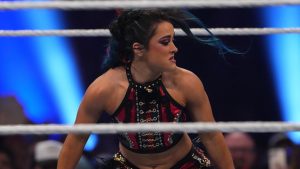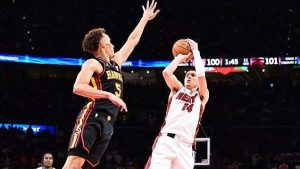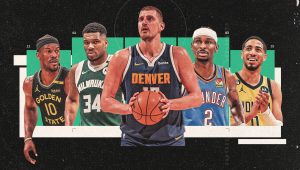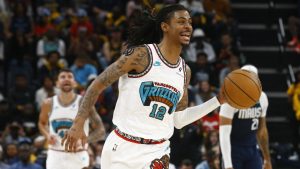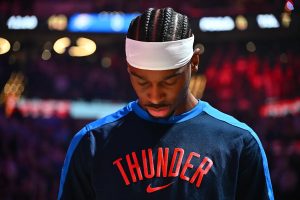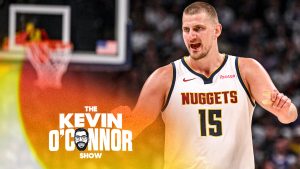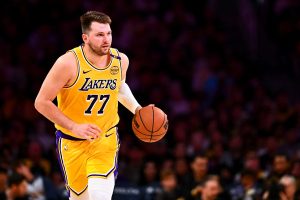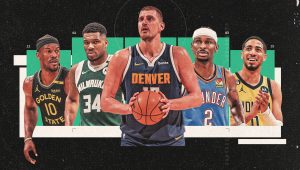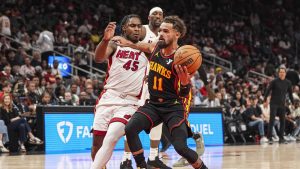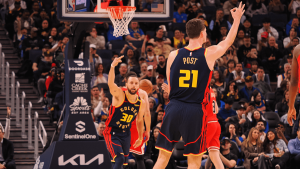The playoffs are the NBA’s truth serum. There’s no hiding, no coasting, just 48 minutes that expose who you really are. With that in mind, here are my top 40 players for the 2025 postseason.
Rankings weigh what players have done lately and what they’ve proven before; proven vets keep their edge for reliability, while potential breakouts still need to validate their hype on the biggest stage. All 40 players are separated into tiers.
Read the list, tell me where I missed, and let’s argue in the comments. We start at No. 40.
TIER 7: THE WILD CARDS
High‑variance players who could disappear entirely, swing a series, or skyrocket up the ranks with a breakout performance.
40. Amen Thompson, Rockets
Amen could climb if the Rockets make a run. On defense he already plays like a veteran stopper. Two weeks ago he hounded Steph Curry into a measly three points, and that stay‑glued intensity lasted all season. I had him first on my Defensive Player of the Year ballot because the numbers back up the eye test: when he was the closest defender, opponents shot 9.7% worse inside six feet, 9.5% worse inside 10, and 5.5% worse beyond 15. He blocked jumpers at one of the highest rates in the league, blew up off‑ball actions, and single‑handedly killed fast breaks while guarding the top option every night.
The swing factor is his offense. Thompson’s superhuman athleticism powered 14.1 points and 3.8 assists, plus a 70% clip in the restricted area, where he finishes through contact like a center and slings smart kick‑outs like a point guard. Outside the paint he managed only a 40.1 effective field‑goal percentage. Whether that gap matters against playoff scouting is the question. I’m betting it will not be a fatal flaw, which is why he lands here with room to soar higher.
39. Darius Garland, Cavaliers
Garland would have landed higher but a February injury disrupted his rhythm. Since then he has averaged 18.2 points on 33.5% from 3 and 47.4% on 2s. The good news is his last two outings against Chicago and New York looked sharp, better resembling who he was pre-injury when he averaged 21.6 points on 63.1% true shooting.
At his best Garland is a skilled playmaker and one of the league’s most clutch guards this season. The concern is his size. Smaller guards often become hunting targets in the playoffs, and that is the question he still has to answer. If he holds up defensively while regaining full explosion, he could vault up this list fast.
38. Rudy Gobert, Timberwolves
The lowlights are burned into everyone’s mind: Steph spinning him around, guards baiting him outside the paint, the limited self‑creation. None of that erases what still makes Gobert matter. After Gobert returned from injury in March, over his final 17 games the Wolves posted a 105.6 defensive rating with him on the floor and 118.6 without. That gap explains why teams drag him to the perimeter: they are desperate to keep a 7‑foot force away from the rim, and have a smaller player occupying that space.
Gobert has not been a liability on defense in any recent playoff run. The concern is offense. On one hand, he’s an elite screener who serves as a constant lob threat and he’s a vacuum on the glass. But if Minnesota’s first-round opponent, the Lakers, is taking the lob away by switching every on-ball screen then it does neutralize his effectiveness and kill offensive spacing. This is the concern for Rudy, but love him or not, his defensive impact keeps him in the top 40.
37. Draymond Green, Warriors
“There are 82-game players, then there are 16-game players.”
Draymond said that almost seven years ago. And here he still is, even at age 35, a critical 16-game player. Green may bring very little as a scorer — we all saw his botched layup against the Clippers — but his value everywhere else is why he stays on this list. As a connective playmaker, his give‑and‑go chemistry with Steph fuels the entire Warriors offense. On the other end he remains an All‑Defensive talent, and he will receive many Defensive Player of the Year votes. For the Warriors to have any chance of winning a fifth ring, they still need Draymond.
36. Jaren Jackson Jr., Grizzlies
JJJ ranks a bit lower here than he would for the regular season because his playoff résumé is underwhelming. Through three trips and 23 total games, he has averaged 15.7 points while hitting only 33.6% of his 3-pointers and offering nothing as a playmaker or rebounder.
The upside is obvious though: his shot creation has broadened this season, and he is still an elite defender. The big swing piece is whether the new‑look offense carries over; if the jumpers fall and he can create some buckets for himself, he can justify a higher spot. But ultimately, it’s unlikely the Grizzlies are getting through the Thunder for it to matter much this year.
35. Paolo Banchero, Magic
The beatdown Orlando is about to experience against Boston will be good for Banchero’s growth. Paolo can bully wings, shake bigs, and live at the line, yet his jumper is still unreliable and his reads against extra help come a beat slow. The Magic offense is so starved for scoring that his counting stats can mask middling efficiency. To climb higher on this list he needs cleaner decisions, a steadier pull‑up, and a greater defensive impact.
But we’ve seen the highs too. Banchero averaged 25.9 points this season and during a March-to-April heater he averaged 30. There’s a chance he uses the playoffs as a chance to break out, but it’s more likely the dominant Celtics defense shows how far he needs to go to become a true star.
34. Franz Wagner, Magic
Wagner is Orlando’s most complete player. He defends better than Banchero, makes quicker reads as a passer, moves smarter without the ball, and finishes with softer touch inside. The one gaping hole is the 3-pointer (for both of them).
Among all players in league history who attempted five or more 3s per game while shooting under 30 % from deep, only Wagner, Jordan Clarkson (2023‑24), and Michael Adams (1990‑91) paired that inaccuracy with a better-than 80% clip at the line. It’s baffling! Wagner’s touch shows up everywhere except beyond the arc. And until the shot catches up, this is as high as he can climb.
Wagner also needs to be better than his horrific 1-for-15 showing in Game 7 last year. He was pretty good in the lead up to that game. But it left a sour taste.
TIER 6: CORE STARTERS
Dependable starters who will close a lot of games, with room to climb the ranks if their postseason performance matches their regular-season success.
33. Aaron Gordon, Nuggets
Denver had its wobbles, including Gordon missing 31 games. But he’s healthy now and looked excellent again when he was active. Just like during Denver’s run to a championship, Gordon remains an elite wing defender and he will be the first line of resistance against Kawhi Leonard in Round 1. On offense he cuts, beats mismatches on the post, and flies down the floor on the break while maintaining a telepathic two‑man game with Nikola Jokić.
The upgrade came with his shot, posting a career‑best 43.6% on 3s and 81% at the line. Add those makes to his glue‑guy screens and extra passes, Gordon once again will be central to the Nuggets’ title hopes.
32. Alperen Şengün, Rockets
Şengün’s breakout year averaging 19‑10‑5 with his first All‑Star nod came on the back of real defensive progress. Golden State will yank him into screening actions and test his defensive mobility in space. Thrive in that matchup and his reputation jumps a tier, because the offensive résumé is already solid. He operates like Jokić Lite, using craft and quickness to score or sling passes.
Still, he is a postseason unknown. Surviving the Warriors’ stress test is his chance to prove he belongs on this stage.
31. OG Anunoby, Knicks
Anunoby’s length, strength, and switch-anywhere versatility gives the Knicks an All-Defensive team defender any time he’s on the floor. The swing factor is offense. Most nights he is a glorified spot‑up threat, knocking down 37.6% of his catch‑and‑shoot 3s, attacking closeouts, and making the easy pass.
Yet we have seen flashes of a different OG, the one who puts the ball on the floor and spins his way to the basket. New York does not need that every possession, but a few doses of downhill aggression complementing Jalen Brunson could be the push that moves this team from contender to champion.
30. Ivica Zubac, Clippers
Zubac was an easy pick for my All‑NBA Third Team because of his two-way excellence this season. On offense, he grabbed a league‑leading 300 offensive boards, finished 73% of his layups and dunks (tip‑ins excluded), and hit 59.3% of hook shots and runners. Zubac is a punishing post presence, and he can pass too; his strong screens and quick reads out of short rolls help fuel the two-man game with James Harden.
On defense, Zubac patrols the interior, where opponents shoot 9% worse with him as the nearest defender. A first-round series will feature a slugfest against Nikola Jokić. The Clippers are +8.9 points per 100 possessions when he plays and –4.3 when he sits. They need him to continue thriving against the Nuggets to have a shot.
29. Austin Reaves, Lakers
Reaves has arrived as a bonafide 20‑point scorer, and he’s done it while keeping his efficiency intact at 61.6% true shooting. He fits cleanly next to Luka Dončić and LeBron James as a third option because he can play however they need him to. Reaves shoots 40% on catch‑and‑shoot 3s, makes crisp cuts, and willingly sets screens. But the Lakers can also give him the ball, and he shines; this season he ranked in the 83rd percentile as a pick‑and‑roll scorer and 80th in isolation.
In 561 minutes without either Luka or LeBron, Los Angeles is +8.8, proof he can drive lineups on his own. You could argue for a higher slot considering his past playoff moments and steady rise all season. For now he sits at 29 while we wait to see if the regular season gains carry over to the postseason.
28. Jrue Holiday, Celtics
Holiday remains one of the league’s top defenders, comfortably switching across positions and snuffing out opponent actions. Offensively, Boston deploys him everywhere: setting screens, cutting from the corner, or spacing above the break. His overall 35.3% from 3 looks underwhelming compared to his blistering 42.9% clip last season, but that number is dragged down by off‑the‑dribble attempts.
On catch‑and‑shoot looks, Holiday drilled 39.5% of 3s. The shot should hold up under playoff pressure, just like it did last year, and his blend of on‑ball creation, connective passing, and rugged defense makes him the kind of winning role player this list values over higher‑volume but less efficient scorers.
TIER 5: SERIES SWINGERS
Solid players most nights, but when they crank the dial up beyond their baseline they can flip a series.
27. Derrick White, Celtics
White remains Boston’s indispensable connector. He is one of the league’s only guards who blocks shots like a rim‑protector, stays glued to ball-handlers at the point of attack, and keeps the entire scheme organized with precise rotations.
Offense is just as clean: he finished second in the league behind teammate Payton Pritchard in scoring efficiency off screens at 1.5 points per chance, a mark better than many of the league’s stars. His catch‑and‑shoot accuracy forces closeouts which he can attack with ease, and he can slide into a secondary creator role if Jaylen Brown misses time. That two‑way reliability makes him a lock for the Top 30.
26. Jamal Murray, Nuggets
Murray’s playoff history speaks for itself with averages of 24.2 points, 6.2 assists, 4.9 rebounds a night, plus a stack of high-scoring affairs and clutch moments. And his two‑man game with Jokić is still an incredibly potent guard‑center partnership.
The regular season was uneven though, starting with conditioning issues and ending with an injury that lingers as the postseason is set to begin. Denver needs a full‑power Murray to win another title, so this becomes a prove‑it postseason for a player who usually saves his best for this time of year.
25. Bam Adebayo, Heat
Neither Bam nor the Heat hit their desired ceiling this year, yet he remains the anchor of a top‑10 defense. Few bigs can switch, hedge, and recover like he does, and Miami’s scheme still runs on that versatility. Offensively he added a jumper, making 35.7% of his 2.8 triples per game. The scoring totals dipped a bit, but his all‑court impact keeps him firmly in the mid‑20s of this ranking.
24. Chet Holmgren, Thunder
Statistically, no one protected the rim better this season. With Holmgren as the nearest defender, opponents shot 18% worse inside six feet. He pairs that elite paint protection with enough perimeter mobility to survive switches and he rebounds well.
The key to his playoff success will be the jumper. Holmgren logged only 26 total shots from isolations or post‑ups all year, which serves as a reminder that his on‑ball game is still in development. But he made 37.9% of his 3-pointers, a nearly equal number to his rookie season. The issue was his percentage dropped to 26% last year in the playoffs. This year, he needs to be better.
But even with room to grow he is already a clear top‑25 player because of the defense and stretch‑5 shooting. The next step is proving those skills translate for an entire playoff run.
23. Jalen Williams, Thunder
Williams is a switchable stopper who also protects the rim statistically like a center; opponents shot 11% worse inside six feet when he was the closest defender, and everyone else in double digits is a big. The defense will translate to the postseason.
The unknown is his offense when Shai Gilgeous‑Alexander sits. Without SGA, he produced 29 points and 7 assists per 75 possessions during the season, tremendous numbers which is why in part he ended up making my All-NBA third team. But last spring his numbers dipped under playoff pressure. Will the same thing happen this year? Or will JDub replicate what he did during the season? It’s one of the keys to unlocking a Finals run for OKC.
22. Damian Lillard, Bucks
Shams Charania reported that Lillard will return sometime during the first round after treatment for a blood clot, which is exactly the boost Milwaukee needs. Sort of. Giannis is in peak form as a high-usage player, so the formula should not change: Dame operates off the ball, punishes rotations with his deep range, and picks his spots as a pick‑and‑roll shot-creator.
The complication is defense. The Bucks have been stingier during his absence, so Lillard will need to hold his own on that end to stay in closing lineups. If he does, the scoring he brings should be enough to tilt a series against the Pacers.
21. Jaylen Brown, Celtics
Brown enters the playoffs nursing a bone‑bruise on his knee, which nudges him lower than you might expect for a reigning Finals MVP. But he wasn’t his peak self this season anyway. Brown shot a career‑worst 3‑point clip. In the playoffs, defenses will choose someone to shade away from, and that could be Brown after he made just 32.4% of catch-and-shoot 3s and 35.8% of 3s off the bounce.
Brown’s playmaking strides are nice but not essential to Boston’s scheme. What they need is his scoring and his defense. Brown spent long stretches guarding Luka Dončić in last year’s Finals and will again draw tough wing assignments during this year’s run. If the knee holds up, he can still swing a series, or a title.
20. Kristaps Porziņģis, Celtics
Everyone talks about the rim protection and the 40% 3-point shooting Porziņģis provides, but his post game is the true X-factor for the Celtics. Early in his career he struggled there, but over the past three seasons he leads all high-volume post players at 1.26 points per post-up. At 7‑foot-3 he can bully smaller defenders, shoot over the top, or kick to Boston’s spot‑up snipers.
Add that scoring option to elite shot-blocking and pick‑and‑pop gravity, and the Celtics have a lineup breaker few teams can counter. If KP stays healthy and keeps punishing mismatches, Boston might be impossible to beat.
19. Pascal Siakam, Pacers
Siakam might be the league’s most underrated player. He won a ring as a role player, but today he is a do‑it‑all weapon who slides between supporting cast and primary option. These numbers are outstanding: He shoots 52% on isolations, 55% on post‑ups, 51% on drives, and 39% on catch‑and‑shoot 3-pointers. Indiana leverages every piece of that skill set, using him to screen for their guards, space in the corners, or initiate offense. Add in his switchable defense and you get a player who fits any lineup.
The first‑round duel with Milwaukee sets him up as the primary defender on Giannis, a stage that could remind everyone just how good Siakam is.
TIER 4: CO-STARS
Co-headliners who could lead their teams but they’re still chasing a signature moment that cements their status.
18. Cade Cunningham, Pistons
I had Cunningham as my Most Improved Player because jumping from a top-75ish guy to second‑team All‑NBA is a bigger leap than anyone else made this season. But now he has to validate it in the playoffs.
Two tests matter most. First, his pull‑up game. He hit 50.4% of his pull‑up midrange jumpers and 33.3% of pull‑up 3s. Will he make the Knicks pay again during the playoffs? In four games versus New York he averaged 30.8 points on a 56/52/80 slash line. Second, he needs to keep getting to the basket. He made 52.6% of shots at the rim this season, a good but not great number. What happens there during the playoffs? Replicate anything close to that and Cunningham will climb this list in a hurry.
17. Karl-Anthony Towns, Knicks
Towns showed real defensive growth in last year’s Jokić matchup, but the next test is anchoring as a lone center. Do the Knicks need to keep two bigs on the floor, or can KAT hold up solo in space and at the rim? In the past, the answer was clearly that he needed frontcourt assistance.
Towns is known for his offense, but can be better in the playoffs. He is a 40% career 3-point shooter in the regular season, but that dips to 35% in the playoffs. New York needs the full regular-season version. If the jumper wobbles, Towns has to find other ways to tilt the floor with bully post‑ups, quick‑hit drives, and playmaking to cutters. His ability to deliver in both roles will determine whether the Knicks make a run or make changes this summer.
16. Ja Morant, Grizzlies
The Grizzlies are unlikely to hang with Oklahoma City, but Morant still ranks this high because he finally looks like himself again. Since Taylor Jenkins was dismissed, he has run more than 30 pick‑and‑rolls a night, living downhill and finishing or spraying passes. The jumper looked good too.
A month ago he would have ranked lower during a sluggish year, but now he better resembles peak Ja. Memphis has unfortunately fallen well behind the Thunder, and now Ja is dealing with an ankle injury. It’ll probably be a quick series for the Grizzlies.
15. Tyrese Haliburton, Pacers
Haliburton is peaking at the right time. Since the All‑Star break he has a 68.1% true shooting, and he sits at 64.7% true shooting dating back to the NBA Cup in December. At this point, his hamstring issue feels like a distant memory.
The question is aggression. Sometimes he hunts the perfect pass instead of the imperfect bucket. Pacers writer Kyle Taylor found this fascinating stat: When Haliburton makes his first shot of the game, he averages 25.2 points on 16.5 attempts per 36 minutes. And if it misses he slides to 16.3 points on 13.7 attempts.
Indiana needs the assertive version who sprinkles pull‑up 3s, mid‑range floaters, and crafty at-rim finishes on top of the dimes. Because we know what he can do as a passer: 9.2 assists with only 1.6 turnovers was the second‑best assist‑to‑turnover ratio ever for a player averaging at least eight dimes. Everyone in Indiana benefits. But the way the Pacers might benefit the most in the playoffs is if Haliburton allows himself to be a superstar scorer.
14. James Harden, Clippers
At 35 years old, Harden logged the fifth‑most minutes in the league and played in 79 games while carrying the Clippers through Kawhi’s long absence. Once Leonard returned, Harden’s efficiency spiked across the board:
Finishes at the rim climbed, the floater fell more often, mid‑range pull‑ups went up, and both catch‑and‑shoot and step‑back 3s ticked up.
Harden’s playoff history is mixed with spectacular highs alongside flameouts. But the context is different now. Harden is the secondary star, freed to pick apart defenses without the weight of being the top option.
13. Evan Mobley, Cavaliers
Mobley built on last year’s playoff success against the Celtics and took a real leap this season, averaging 18.5 points, 3.2 assists, and hitting 37% of 3s on a career‑high 3.2 attempts. After the break he cranked that up to more than four triples a night, clearly prepping for postseason spacing.
Defensively he is already elite and could win Defensive Player of the Year. But how much his newfound offense translates will decide how high Cleveland’s ceiling climbs.
12. Jimmy Butler, Warriors
After a stinker of a performance against the Rockets a couple weeks ago, it seems like Butler has activated Playoff Jimmy mode. Over his last four games, he averaged 30 points, 7.3 assists, 4.3 rebounds, and two steals while playing elite defense. This is the player the Warriors hoped to acquire.
The one hitch is the jumper. He’s made only 27.9% of his triples in a Warriors uniform. Houston will sag, load the paint, and force him to shoot. If the 3-ball cooperates even a little, Butler’s two‑way impact can carry Golden State deep. And even if it doesn’t, it sure will be nice for him to have Steph and Draymond by his side.
11. Donovan Mitchell, Cavaliers
Mitchell already owns a strong playoff record: 28.1 points on 55.9% true shooting across 54 postseason games, essentially matching his regular‑season efficiency at higher volume. His three years in Cleveland have produced the best shooting lines of his career, and he now has the deepest roster he has ever played with.
Garland’s creation lightens the playmaking load, while Mobley, Jarrett Allen, and a wave of switchable wings mask defensive gaps. The stage is set for Mitchell to push beyond his usual level and lead his team to a championship.
10. Jalen Brunson, Knicks
Brunson powers New York’s offense with 26 points a night, an array of pull‑up jumpers, crafty footwork in the paint, and a strong playmaking feel.
What Knicks head coach Tom Thibodeau needs to figure out is Brunson’s workload. Brunson led the league in time of possession with the ball in his hands when he was on the floor. A slight dial‑back could help. We saw the benefits of a more diverse attack during his recent absence. So giving OG Anunoby, Karl‑Anthony Towns, and Mikal Bridges room to run actions would diversify the attack and let Brunson work as a catch‑and‑shoot threat.
Extra off‑ball reps would buy him breathers and keep his legs fresh for late‑game isolations, when New York still needs him to close.
TIER 3: LEAD DOGS
Faces of the franchise who can carry a team for long stretches, but still need more support to win in the deepest rounds.
9. Kawhi Leonard, Clippers
From 2017 through 2023, Leonard logged 62 playoff games and averaged 29.6 points, 8.5 rebounds, 4.5 assists, while shooting 56% on 2s, 39% on 3s, and 89% at the line. That is Hall of Fame level stuff.
And yes, injuries have derailed his last three postseasons and the risk lingers. But the version we see right now looks unstoppable. Leonard averaged 25.5 points, 6.9 rebounds, 3.4 assists on 61.6% true shooting.
Maybe this is the year he makes it to the finish like he did in 2019 with the Raptors.
8. Anthony Edwards, Timberwolves
If Minnesota is going to navigate a bracket that will include Luka and LeBron, and then either Steph or Houston’s swarming defense before even getting to the West finals, Ant has to reach a new level under real pressure.
Edwards received blitz coverage on 15% of his pick‑and‑rolls, the highest rate in the league and well above other high‑volume handlers. Among the top 25 pick-and-roll users, only Steph and Luka even crack 10%.
In last year’s playoffs blitzes spiked further, so he knows what is coming. If Edwards blends timely playmaking with his downhill power and newfound-elite 3-point jumper, the Timberwolves can beat anyone. But it will not be easy.
7. Jayson Tatum, Celtics
Tatum is both a champion and a question mark. Because during Boston’s run, his own shortcomings showed he can still tap into a higher level. He anchored the defense with switchability, pounded the glass at an elite rate for a wing, and flashed the best playmaking feel of his career, dishing 7.2 assists per game in the Finals. What he did not do was score like he can. He hit under 30% of his 3s and his efficiency on isolations and post‑ups fell from 45.7% during the season to 35.6% in the playoffs.
This year he finished those same actions at 43.7%, good for the 75th percentile. If that version shows up in May and June, odds are he’ll end up the frontrunner for his first Finals MVP. But even if the jumper stalls again, his defensive versatility, rebounding, and improved table‑setting keep him firmly near the top of the NBA.
6. Stephen Curry, Warriors
Curry averaged 27.8 points while hitting 39.8% of 3s over his final 30 games, making back‑breaking shots as he whirled around screens and defined every possession with constant movement. One of the reasons I was concerned about Golden State’s upside early in the year is because Steph didn’t look quite the same. His scoring volume was down, especially inside the arc. He converted just 51% of unassisted at-rim attempts, well below his career norm of 60%. Since Jimmy Butler was acquired, that number is back to 61%.
When Steph is bending defenses from the perimeter and finishing at the rim with craft, Golden State’s entire system clicks into place.
5. LeBron James, Lakers
Age 40 and still dominant. It’s hard to fathom. But LeBron finished this season averaging 24.4 points, 8.2 assists, and 7.8 rebounds while shooting the ball better than ever. He posted a career-high clip from the free throw line and made 41% of his catch-and-shoot 3s. With Luka Dončić by his side, the scoring menu is as deep as ever. When he screens for Luka, the Lakers score 1.6 points per play, because either Luka is scoring one-on-one or LeBron is slipping into the paint, popping for a 3, or attacking a mismatch of his own.
LeBron moves into the top five though because of his defense. At times this season, he’s looked like he’s doing a Draymond impression. If he’s able to keep up the intensity in the playoffs, there’s no telling how far the Lakers could go. Especially when, for the first postseason of his career, LeBron doesn’t need to be the best player on his team every single night.
TIER 2: ONE-MAN BANDS
Superstars who can be given just about any roster and they’re capable of leading them to a series in late May.
4. Luka Dončić, Lakers
At age 21 and 22, we saw Luka go toe-to-toe with Kawhi. Age 23, he dragged the Mavs to the West finals. At age 25, he led them to the NBA Finals. It’s a safe bet your team will go far with Luka.
And since March, he is rolling at 30.6 points, 7.9 assists, and 7.9 boards with elite efficiency. He will share about 70% of his minutes with LeBron, yet in the 30% without him he explodes to 38.3 points, 10 boards, and 8.8 assists per 75 possessions on 59.6% true shooting.
With Dončić orchestrating and plenty of help beside him, it is hard to imagine Los Angeles bowing out early. For Luka to regain his top-3 status though, and to win his first title, he’ll need to be better defensively to help support LA’s defense.
3. Shai Gilgeous-Alexander, Thunder
Gilgeous‑Alexander was my MVP pick, but he lands third here because the final proof comes in May and June. He dominated last postseason over 10 games, and Oklahoma City’s six‑game loss to Dallas was not on him, but the bar he is chasing is Giannis and Jokić-level consistency in the playoffs.
SGA’s regular season was historic though. He averaged 32.7 points, 6.4 assists, five rebounds, and a combined 2.7 steals plus blocks on 60% true shooting. Only Michael Jordan (three times) and James Harden (twice) have matched those lines, and neither of them pushed their teams past 55 wins in those seasons. Shai led the Thunder to 68, carrying heavy creation duties and serving as an excellent defender.
If he takes his already absurd baseline up even one notch, he will climb this list quickly. Given the trajectory, and given the talent on OKC, betting against that jump feels unwise.
2. Giannis Antetokounmpo, Bucks
The season looked like it might unravel around Giannis. Khris Middleton fell off a cliff and was traded. Lillard got sidelined by a blood clot. Bobby Portis was suspended. But Milwaukee still won 48 because Giannis stayed in MVP form, while also improving his midrange pull-up to add a new dimension to his offense.
Over the final month the Bucks leaned into four‑shooter lineups and Antetokounmpo leveled up again by averaging 31.8 points, 12 rebounds, 11.8 assists, and just 1.7 turnovers per game. We’ve seen Giannis score and rebound like that for many years now. But the passing? Sheesh. He had a 7.2 assist‑to‑turnover ratio while handling nearly 100 touches a night. It was different. He sprayed passes to every corner, stayed poised against extra help, and powered an offense that suddenly was humming more than it ever had with Dame.
Lillard will return at some point. But Point Giannis needs to remain the plan. Run the show through Giannis, let him dictate the tempo, and rely on Dame off-ball while picking his spots as a creator. If Antetokounmpo leads the Bucks to an unthinkable run through the Pacers, then through the Cavaliers, and then through the Celtics, he very well could reclaim the Best Player Alive title.
TIER 1: THE WORLD’S GREATEST
The undisputed best player in the world, though others are coming for his crown.
1. Nikola Jokić, Nuggets
Jokić is still the best player in the world. And we just witnessed one of the greatest offensive seasons in the history of basketball. Night in, night out, Jokić did something amazing. He ended up averaging 29.6 points, 12.7 rebounds, and 10.2 assists while posting the second‑best efficiency mark of his career. He did it on higher volume too, taking roughly five more shots per game than in 2022‑23. This is in part because of his improved weapon: the jumper. Jokić made 41.7% of his 3s, which unlocked his game even more than anyone thought it could be.
The variables lie elsewhere. Jamal Murray’s health will determine how much shot creation help Jokić receives, and the Nuggets bring a bottom‑10 defensive rating into the postseason. For a repeat run, Jokić must anchor enough stops in drop coverage, bang on the glass, and get help from his supporting cast. With such a heavy offensive load this season, Jokić wasn’t able to bring it the same way he has on defense in recent years. But in the playoffs he’ll need to in order to carry the Nuggets back to the summit.
The playoffs are the NBA’s truth serum. There’s no hiding, no coasting, just 48 minutes that expose who you really are. With that in mind, here are my top 40 players for the 2025 postseason.
Rankings weigh what players have done lately and what they’ve proven before; proven vets keep their edge for reliability, while potential breakouts still need to validate their hype on the biggest stage. All 40 players are separated into tiers.
Advertisement
Advertisement
Advertisement
Read the list, tell me where I missed, and let’s argue in the comments. We start at No. 40.
High‑variance players who could disappear entirely, swing a series, or skyrocket up the ranks with a breakout performance.
Amen could climb if the Rockets make a run. On defense he already plays like a veteran stopper. Two weeks ago he hounded Steph Curry into a measly three points, and that stay‑glued intensity lasted all season. I had him first on my Defensive Player of the Year ballot because the numbers back up the eye test: when he was the closest defender, opponents shot 9.7% worse inside six feet, 9.5% worse inside 10, and 5.5% worse beyond 15. He blocked jumpers at one of the highest rates in the league, blew up off‑ball actions, and single‑handedly killed fast breaks while guarding the top option every night.
Advertisement
Advertisement
Advertisement
The swing factor is his offense. Thompson’s superhuman athleticism powered 14.1 points and 3.8 assists, plus a 70% clip in the restricted area, where he finishes through contact like a center and slings smart kick‑outs like a point guard. Outside the paint he managed only a 40.1 effective field‑goal percentage. Whether that gap matters against playoff scouting is the question. I’m betting it will not be a fatal flaw, which is why he lands here with room to soar higher.
Garland would have landed higher but a February injury disrupted his rhythm. Since then he has averaged 18.2 points on 33.5% from 3 and 47.4% on 2s. The good news is his last two outings against Chicago and New York looked sharp, better resembling who he was pre-injury when he averaged 21.6 points on 63.1% true shooting.
Advertisement
Advertisement
Advertisement
At his best Garland is a skilled playmaker and one of the league’s most clutch guards this season. The concern is his size. Smaller guards often become hunting targets in the playoffs, and that is the question he still has to answer. If he holds up defensively while regaining full explosion, he could vault up this list fast.
The lowlights are burned into everyone’s mind: Steph spinning him around, guards baiting him outside the paint, the limited self‑creation. None of that erases what still makes Gobert matter. After Gobert returned from injury in March, over his final 17 games the Wolves posted a 105.6 defensive rating with him on the floor and 118.6 without. That gap explains why teams drag him to the perimeter: they are desperate to keep a 7‑foot force away from the rim, and have a smaller player occupying that space.
Gobert has not been a liability on defense in any recent playoff run. The concern is offense. On one hand, he’s an elite screener who serves as a constant lob threat and he’s a vacuum on the glass. But if Minnesota’s first-round opponent, the Lakers, is taking the lob away by switching every on-ball screen then it does neutralize his effectiveness and kill offensive spacing. This is the concern for Rudy, but love him or not, his defensive impact keeps him in the top 40.
“There are 82-game players, then there are 16-game players.”
Advertisement
Advertisement
Advertisement
Draymond said that almost seven years ago. And here he still is, even at age 35, a critical 16-game player. Green may bring very little as a scorer — we all saw his botched layup against the Clippers — but his value everywhere else is why he stays on this list. As a connective playmaker, his give‑and‑go chemistry with Steph fuels the entire Warriors offense. On the other end he remains an All‑Defensive talent, and he will receive many Defensive Player of the Year votes. For the Warriors to have any chance of winning a fifth ring, they still need Draymond.
JJJ ranks a bit lower here than he would for the regular season because his playoff résumé is underwhelming. Through three trips and 23 total games, he has averaged 15.7 points while hitting only 33.6% of his 3-pointers and offering nothing as a playmaker or rebounder.
The upside is obvious though: his shot creation has broadened this season, and he is still an elite defender. The big swing piece is whether the new‑look offense carries over; if the jumpers fall and he can create some buckets for himself, he can justify a higher spot. But ultimately, it’s unlikely the Grizzlies are getting through the Thunder for it to matter much this year.
The beatdown Orlando is about to experience against Boston will be good for Banchero’s growth. Paolo can bully wings, shake bigs, and live at the line, yet his jumper is still unreliable and his reads against extra help come a beat slow. The Magic offense is so starved for scoring that his counting stats can mask middling efficiency. To climb higher on this list he needs cleaner decisions, a steadier pull‑up, and a greater defensive impact.
Advertisement
Advertisement
Advertisement
But we’ve seen the highs too. Banchero averaged 25.9 points this season and during a March-to-April heater he averaged 30. There’s a chance he uses the playoffs as a chance to break out, but it’s more likely the dominant Celtics defense shows how far he needs to go to become a true star.
Wagner is Orlando’s most complete player. He defends better than Banchero, makes quicker reads as a passer, moves smarter without the ball, and finishes with softer touch inside. The one gaping hole is the 3-pointer (for both of them).
Among all players in league history who attempted five or more 3s per game while shooting under 30 % from deep, only Wagner, Jordan Clarkson (2023‑24), and Michael Adams (1990‑91) paired that inaccuracy with a better-than 80% clip at the line. It’s baffling! Wagner’s touch shows up everywhere except beyond the arc. And until the shot catches up, this is as high as he can climb.
Advertisement
Advertisement
Advertisement
Wagner also needs to be better than his horrific 1-for-15 showing in Game 7 last year. He was pretty good in the lead up to that game. But it left a sour taste.
Dependable starters who will close a lot of games, with room to climb the ranks if their postseason performance matches their regular-season success.
Denver had its wobbles, including Gordon missing 31 games. But he’s healthy now and looked excellent again when he was active. Just like during Denver’s run to a championship, Gordon remains an elite wing defender and he will be the first line of resistance against Kawhi Leonard in Round 1. On offense he cuts, beats mismatches on the post, and flies down the floor on the break while maintaining a telepathic two‑man game with Nikola Jokić.
Advertisement
Advertisement
Advertisement
The upgrade came with his shot, posting a career‑best 43.6% on 3s and 81% at the line. Add those makes to his glue‑guy screens and extra passes, Gordon once again will be central to the Nuggets’ title hopes.
Şengün’s breakout year averaging 19‑10‑5 with his first All‑Star nod came on the back of real defensive progress. Golden State will yank him into screening actions and test his defensive mobility in space. Thrive in that matchup and his reputation jumps a tier, because the offensive résumé is already solid. He operates like Jokić Lite, using craft and quickness to score or sling passes.
Still, he is a postseason unknown. Surviving the Warriors’ stress test is his chance to prove he belongs on this stage.
Anunoby’s length, strength, and switch-anywhere versatility gives the Knicks an All-Defensive team defender any time he’s on the floor. The swing factor is offense. Most nights he is a glorified spot‑up threat, knocking down 37.6% of his catch‑and‑shoot 3s, attacking closeouts, and making the easy pass.
Advertisement
Advertisement
Advertisement
Yet we have seen flashes of a different OG, the one who puts the ball on the floor and spins his way to the basket. New York does not need that every possession, but a few doses of downhill aggression complementing Jalen Brunson could be the push that moves this team from contender to champion.
Zubac was an easy pick for my All‑NBA Third Team because of his two-way excellence this season. On offense, he grabbed a league‑leading 300 offensive boards, finished 73% of his layups and dunks (tip‑ins excluded), and hit 59.3% of hook shots and runners. Zubac is a punishing post presence, and he can pass too; his strong screens and quick reads out of short rolls help fuel the two-man game with James Harden.
On defense, Zubac patrols the interior, where opponents shoot 9% worse with him as the nearest defender. A first-round series will feature a slugfest against Nikola Jokić. The Clippers are +8.9 points per 100 possessions when he plays and –4.3 when he sits. They need him to continue thriving against the Nuggets to have a shot.
Reaves has arrived as a bonafide 20‑point scorer, and he’s done it while keeping his efficiency intact at 61.6% true shooting. He fits cleanly next to Luka Dončić and LeBron James as a third option because he can play however they need him to. Reaves shoots 40% on catch‑and‑shoot 3s, makes crisp cuts, and willingly sets screens. But the Lakers can also give him the ball, and he shines; this season he ranked in the 83rd percentile as a pick‑and‑roll scorer and 80th in isolation.
Advertisement
Advertisement
Advertisement
In 561 minutes without either Luka or LeBron, Los Angeles is +8.8, proof he can drive lineups on his own. You could argue for a higher slot considering his past playoff moments and steady rise all season. For now he sits at 29 while we wait to see if the regular season gains carry over to the postseason.
Holiday remains one of the league’s top defenders, comfortably switching across positions and snuffing out opponent actions. Offensively, Boston deploys him everywhere: setting screens, cutting from the corner, or spacing above the break. His overall 35.3% from 3 looks underwhelming compared to his blistering 42.9% clip last season, but that number is dragged down by off‑the‑dribble attempts.
On catch‑and‑shoot looks, Holiday drilled 39.5% of 3s. The shot should hold up under playoff pressure, just like it did last year, and his blend of on‑ball creation, connective passing, and rugged defense makes him the kind of winning role player this list values over higher‑volume but less efficient scorers.
Solid players most nights, but when they crank the dial up beyond their baseline they can flip a series.
White remains Boston’s indispensable connector. He is one of the league’s only guards who blocks shots like a rim‑protector, stays glued to ball-handlers at the point of attack, and keeps the entire scheme organized with precise rotations.
Advertisement
Advertisement
Advertisement
Offense is just as clean: he finished second in the league behind teammate Payton Pritchard in scoring efficiency off screens at 1.5 points per chance, a mark better than many of the league’s stars. His catch‑and‑shoot accuracy forces closeouts which he can attack with ease, and he can slide into a secondary creator role if Jaylen Brown misses time. That two‑way reliability makes him a lock for the Top 30.
Murray’s playoff history speaks for itself with averages of 24.2 points, 6.2 assists, 4.9 rebounds a night, plus a stack of high-scoring affairs and clutch moments. And his two‑man game with Jokić is still an incredibly potent guard‑center partnership.
The regular season was uneven though, starting with conditioning issues and ending with an injury that lingers as the postseason is set to begin. Denver needs a full‑power Murray to win another title, so this becomes a prove‑it postseason for a player who usually saves his best for this time of year.
Neither Bam nor the Heat hit their desired ceiling this year, yet he remains the anchor of a top‑10 defense. Few bigs can switch, hedge, and recover like he does, and Miami’s scheme still runs on that versatility. Offensively he added a jumper, making 35.7% of his 2.8 triples per game. The scoring totals dipped a bit, but his all‑court impact keeps him firmly in the mid‑20s of this ranking.
Statistically, no one protected the rim better this season. With Holmgren as the nearest defender, opponents shot 18% worse inside six feet. He pairs that elite paint protection with enough perimeter mobility to survive switches and he rebounds well.
Advertisement
Advertisement
Advertisement
The key to his playoff success will be the jumper. Holmgren logged only 26 total shots from isolations or post‑ups all year, which serves as a reminder that his on‑ball game is still in development. But he made 37.9% of his 3-pointers, a nearly equal number to his rookie season. The issue was his percentage dropped to 26% last year in the playoffs. This year, he needs to be better.
But even with room to grow he is already a clear top‑25 player because of the defense and stretch‑5 shooting. The next step is proving those skills translate for an entire playoff run.
Williams is a switchable stopper who also protects the rim statistically like a center; opponents shot 11% worse inside six feet when he was the closest defender, and everyone else in double digits is a big. The defense will translate to the postseason.
Advertisement
Advertisement
Advertisement
The unknown is his offense when Shai Gilgeous‑Alexander sits. Without SGA, he produced 29 points and 7 assists per 75 possessions during the season, tremendous numbers which is why in part he ended up making my All-NBA third team. But last spring his numbers dipped under playoff pressure. Will the same thing happen this year? Or will JDub replicate what he did during the season? It’s one of the keys to unlocking a Finals run for OKC.
Shams Charania reported that Lillard will return sometime during the first round after treatment for a blood clot, which is exactly the boost Milwaukee needs. Sort of. Giannis is in peak form as a high-usage player, so the formula should not change: Dame operates off the ball, punishes rotations with his deep range, and picks his spots as a pick‑and‑roll shot-creator.
Advertisement
Advertisement
Advertisement
The complication is defense. The Bucks have been stingier during his absence, so Lillard will need to hold his own on that end to stay in closing lineups. If he does, the scoring he brings should be enough to tilt a series against the Pacers.
Brown enters the playoffs nursing a bone‑bruise on his knee, which nudges him lower than you might expect for a reigning Finals MVP. But he wasn’t his peak self this season anyway. Brown shot a career‑worst 3‑point clip. In the playoffs, defenses will choose someone to shade away from, and that could be Brown after he made just 32.4% of catch-and-shoot 3s and 35.8% of 3s off the bounce.
Brown’s playmaking strides are nice but not essential to Boston’s scheme. What they need is his scoring and his defense. Brown spent long stretches guarding Luka Dončić in last year’s Finals and will again draw tough wing assignments during this year’s run. If the knee holds up, he can still swing a series, or a title.
Everyone talks about the rim protection and the 40% 3-point shooting Porziņģis provides, but his post game is the true X-factor for the Celtics. Early in his career he struggled there, but over the past three seasons he leads all high-volume post players at 1.26 points per post-up. At 7‑foot-3 he can bully smaller defenders, shoot over the top, or kick to Boston’s spot‑up snipers.
Advertisement
Advertisement
Advertisement
Add that scoring option to elite shot-blocking and pick‑and‑pop gravity, and the Celtics have a lineup breaker few teams can counter. If KP stays healthy and keeps punishing mismatches, Boston might be impossible to beat.
Siakam might be the league’s most underrated player. He won a ring as a role player, but today he is a do‑it‑all weapon who slides between supporting cast and primary option. These numbers are outstanding: He shoots 52% on isolations, 55% on post‑ups, 51% on drives, and 39% on catch‑and‑shoot 3-pointers. Indiana leverages every piece of that skill set, using him to screen for their guards, space in the corners, or initiate offense. Add in his switchable defense and you get a player who fits any lineup.
The first‑round duel with Milwaukee sets him up as the primary defender on Giannis, a stage that could remind everyone just how good Siakam is.
Co-headliners who could lead their teams but they’re still chasing a signature moment that cements their status.
I had Cunningham as my Most Improved Player because jumping from a top-75ish guy to second‑team All‑NBA is a bigger leap than anyone else made this season. But now he has to validate it in the playoffs.
Advertisement
Advertisement
Advertisement
Two tests matter most. First, his pull‑up game. He hit 50.4% of his pull‑up midrange jumpers and 33.3% of pull‑up 3s. Will he make the Knicks pay again during the playoffs? In four games versus New York he averaged 30.8 points on a 56/52/80 slash line. Second, he needs to keep getting to the basket. He made 52.6% of shots at the rim this season, a good but not great number. What happens there during the playoffs? Replicate anything close to that and Cunningham will climb this list in a hurry.
Towns showed real defensive growth in last year’s Jokić matchup, but the next test is anchoring as a lone center. Do the Knicks need to keep two bigs on the floor, or can KAT hold up solo in space and at the rim? In the past, the answer was clearly that he needed frontcourt assistance.
Advertisement
Advertisement
Advertisement
Towns is known for his offense, but can be better in the playoffs. He is a 40% career 3-point shooter in the regular season, but that dips to 35% in the playoffs. New York needs the full regular-season version. If the jumper wobbles, Towns has to find other ways to tilt the floor with bully post‑ups, quick‑hit drives, and playmaking to cutters. His ability to deliver in both roles will determine whether the Knicks make a run or make changes this summer.
The Grizzlies are unlikely to hang with Oklahoma City, but Morant still ranks this high because he finally looks like himself again. Since Taylor Jenkins was dismissed, he has run more than 30 pick‑and‑rolls a night, living downhill and finishing or spraying passes. The jumper looked good too.
A month ago he would have ranked lower during a sluggish year, but now he better resembles peak Ja. Memphis has unfortunately fallen well behind the Thunder, and now Ja is dealing with an ankle injury. It’ll probably be a quick series for the Grizzlies.
Haliburton is peaking at the right time. Since the All‑Star break he has a 68.1% true shooting, and he sits at 64.7% true shooting dating back to the NBA Cup in December. At this point, his hamstring issue feels like a distant memory.
Advertisement
Advertisement
Advertisement
The question is aggression. Sometimes he hunts the perfect pass instead of the imperfect bucket. Pacers writer Kyle Taylor found this fascinating stat: When Haliburton makes his first shot of the game, he averages 25.2 points on 16.5 attempts per 36 minutes. And if it misses he slides to 16.3 points on 13.7 attempts.
Indiana needs the assertive version who sprinkles pull‑up 3s, mid‑range floaters, and crafty at-rim finishes on top of the dimes. Because we know what he can do as a passer: 9.2 assists with only 1.6 turnovers was the second‑best assist‑to‑turnover ratio ever for a player averaging at least eight dimes. Everyone in Indiana benefits. But the way the Pacers might benefit the most in the playoffs is if Haliburton allows himself to be a superstar scorer.
At 35 years old, Harden logged the fifth‑most minutes in the league and played in 79 games while carrying the Clippers through Kawhi’s long absence. Once Leonard returned, Harden’s efficiency spiked across the board:
Advertisement
Advertisement
Advertisement
Finishes at the rim climbed, the floater fell more often, mid‑range pull‑ups went up, and both catch‑and‑shoot and step‑back 3s ticked up.
Harden’s playoff history is mixed with spectacular highs alongside flameouts. But the context is different now. Harden is the secondary star, freed to pick apart defenses without the weight of being the top option.
Mobley built on last year’s playoff success against the Celtics and took a real leap this season, averaging 18.5 points, 3.2 assists, and hitting 37% of 3s on a career‑high 3.2 attempts. After the break he cranked that up to more than four triples a night, clearly prepping for postseason spacing.
Advertisement
Advertisement
Advertisement
Defensively he is already elite and could win Defensive Player of the Year. But how much his newfound offense translates will decide how high Cleveland’s ceiling climbs.
After a stinker of a performance against the Rockets a couple weeks ago, it seems like Butler has activated Playoff Jimmy mode. Over his last four games, he averaged 30 points, 7.3 assists, 4.3 rebounds, and two steals while playing elite defense. This is the player the Warriors hoped to acquire.
The one hitch is the jumper. He’s made only 27.9% of his triples in a Warriors uniform. Houston will sag, load the paint, and force him to shoot. If the 3-ball cooperates even a little, Butler’s two‑way impact can carry Golden State deep. And even if it doesn’t, it sure will be nice for him to have Steph and Draymond by his side.
Mitchell already owns a strong playoff record: 28.1 points on 55.9% true shooting across 54 postseason games, essentially matching his regular‑season efficiency at higher volume. His three years in Cleveland have produced the best shooting lines of his career, and he now has the deepest roster he has ever played with.
Advertisement
Advertisement
Advertisement
Garland’s creation lightens the playmaking load, while Mobley, Jarrett Allen, and a wave of switchable wings mask defensive gaps. The stage is set for Mitchell to push beyond his usual level and lead his team to a championship.
Brunson powers New York’s offense with 26 points a night, an array of pull‑up jumpers, crafty footwork in the paint, and a strong playmaking feel.
What Knicks head coach Tom Thibodeau needs to figure out is Brunson’s workload. Brunson led the league in time of possession with the ball in his hands when he was on the floor. A slight dial‑back could help. We saw the benefits of a more diverse attack during his recent absence. So giving OG Anunoby, Karl‑Anthony Towns, and Mikal Bridges room to run actions would diversify the attack and let Brunson work as a catch‑and‑shoot threat.
Extra off‑ball reps would buy him breathers and keep his legs fresh for late‑game isolations, when New York still needs him to close.
Faces of the franchise who can carry a team for long stretches, but still need more support to win in the deepest rounds.
From 2017 through 2023, Leonard logged 62 playoff games and averaged 29.6 points, 8.5 rebounds, 4.5 assists, while shooting 56% on 2s, 39% on 3s, and 89% at the line. That is Hall of Fame level stuff.
And yes, injuries have derailed his last three postseasons and the risk lingers. But the version we see right now looks unstoppable. Leonard averaged 25.5 points, 6.9 rebounds, 3.4 assists on 61.6% true shooting.
Maybe this is the year he makes it to the finish like he did in 2019 with the Raptors.
If Minnesota is going to navigate a bracket that will include Luka and LeBron, and then either Steph or Houston’s swarming defense before even getting to the West finals, Ant has to reach a new level under real pressure.
Edwards received blitz coverage on 15% of his pick‑and‑rolls, the highest rate in the league and well above other high‑volume handlers. Among the top 25 pick-and-roll users, only Steph and Luka even crack 10%.
In last year’s playoffs blitzes spiked further, so he knows what is coming. If Edwards blends timely playmaking with his downhill power and newfound-elite 3-point jumper, the Timberwolves can beat anyone. But it will not be easy.
Tatum is both a champion and a question mark. Because during Boston’s run, his own shortcomings showed he can still tap into a higher level. He anchored the defense with switchability, pounded the glass at an elite rate for a wing, and flashed the best playmaking feel of his career, dishing 7.2 assists per game in the Finals. What he did not do was score like he can. He hit under 30% of his 3s and his efficiency on isolations and post‑ups fell from 45.7% during the season to 35.6% in the playoffs.
This year he finished those same actions at 43.7%, good for the 75th percentile. If that version shows up in May and June, odds are he’ll end up the frontrunner for his first Finals MVP. But even if the jumper stalls again, his defensive versatility, rebounding, and improved table‑setting keep him firmly near the top of the NBA.
Curry averaged 27.8 points while hitting 39.8% of 3s over his final 30 games, making back‑breaking shots as he whirled around screens and defined every possession with constant movement. One of the reasons I was concerned about Golden State’s upside early in the year is because Steph didn’t look quite the same. His scoring volume was down, especially inside the arc. He converted just 51% of unassisted at-rim attempts, well below his career norm of 60%. Since Jimmy Butler was acquired, that number is back to 61%.
When Steph is bending defenses from the perimeter and finishing at the rim with craft, Golden State’s entire system clicks into place.
Age 40 and still dominant. It’s hard to fathom. But LeBron finished this season averaging 24.4 points, 8.2 assists, and 7.8 rebounds while shooting the ball better than ever. He posted a career-high clip from the free throw line and made 41% of his catch-and-shoot 3s. With Luka Dončić by his side, the scoring menu is as deep as ever. When he screens for Luka, the Lakers score 1.6 points per play, because either Luka is scoring one-on-one or LeBron is slipping into the paint, popping for a 3, or attacking a mismatch of his own.
LeBron moves into the top five though because of his defense. At times this season, he’s looked like he’s doing a Draymond impression. If he’s able to keep up the intensity in the playoffs, there’s no telling how far the Lakers could go. Especially when, for the first postseason of his career, LeBron doesn’t need to be the best player on his team every single night.
Superstars who can be given just about any roster and they’re capable of leading them to a series in late May.
At age 21 and 22, we saw Luka go toe-to-toe with Kawhi. Age 23, he dragged the Mavs to the West finals. At age 25, he led them to the NBA Finals. It’s a safe bet your team will go far with Luka.
And since March, he is rolling at 30.6 points, 7.9 assists, and 7.9 boards with elite efficiency. He will share about 70% of his minutes with LeBron, yet in the 30% without him he explodes to 38.3 points, 10 boards, and 8.8 assists per 75 possessions on 59.6% true shooting.
With Dončić orchestrating and plenty of help beside him, it is hard to imagine Los Angeles bowing out early. For Luka to regain his top-3 status though, and to win his first title, he’ll need to be better defensively to help support LA’s defense.
Gilgeous‑Alexander was my MVP pick, but he lands third here because the final proof comes in May and June. He dominated last postseason over 10 games, and Oklahoma City’s six‑game loss to Dallas was not on him, but the bar he is chasing is Giannis and Jokić-level consistency in the playoffs.
SGA’s regular season was historic though. He averaged 32.7 points, 6.4 assists, five rebounds, and a combined 2.7 steals plus blocks on 60% true shooting. Only Michael Jordan (three times) and James Harden (twice) have matched those lines, and neither of them pushed their teams past 55 wins in those seasons. Shai led the Thunder to 68, carrying heavy creation duties and serving as an excellent defender.
If he takes his already absurd baseline up even one notch, he will climb this list quickly. Given the trajectory, and given the talent on OKC, betting against that jump feels unwise.
The season looked like it might unravel around Giannis. Khris Middleton fell off a cliff and was traded. Lillard got sidelined by a blood clot. Bobby Portis was suspended. But Milwaukee still won 48 because Giannis stayed in MVP form, while also improving his midrange pull-up to add a new dimension to his offense.
Over the final month the Bucks leaned into four‑shooter lineups and Antetokounmpo leveled up again by averaging 31.8 points, 12 rebounds, 11.8 assists, and just 1.7 turnovers per game. We’ve seen Giannis score and rebound like that for many years now. But the passing? Sheesh. He had a 7.2 assist‑to‑turnover ratio while handling nearly 100 touches a night. It was different. He sprayed passes to every corner, stayed poised against extra help, and powered an offense that suddenly was humming more than it ever had with Dame.
Lillard will return at some point. But Point Giannis needs to remain the plan. Run the show through Giannis, let him dictate the tempo, and rely on Dame off-ball while picking his spots as a creator. If Antetokounmpo leads the Bucks to an unthinkable run through the Pacers, then through the Cavaliers, and then through the Celtics, he very well could reclaim the Best Player Alive title.
The undisputed best player in the world, though others are coming for his crown.
Jokić is still the best player in the world. And we just witnessed one of the greatest offensive seasons in the history of basketball. Night in, night out, Jokić did something amazing. He ended up averaging 29.6 points, 12.7 rebounds, and 10.2 assists while posting the second‑best efficiency mark of his career. He did it on higher volume too, taking roughly five more shots per game than in 2022‑23. This is in part because of his improved weapon: the jumper. Jokić made 41.7% of his 3s, which unlocked his game even more than anyone thought it could be.
The variables lie elsewhere. Jamal Murray’s health will determine how much shot creation help Jokić receives, and the Nuggets bring a bottom‑10 defensive rating into the postseason. For a repeat run, Jokić must anchor enough stops in drop coverage, bang on the glass, and get help from his supporting cast. With such a heavy offensive load this season, Jokić wasn’t able to bring it the same way he has on defense in recent years. But in the playoffs he’ll need to in order to carry the Nuggets back to the summit.


